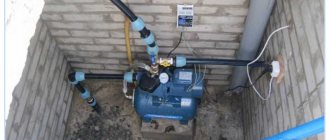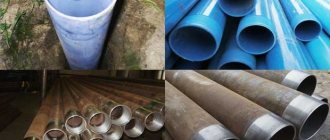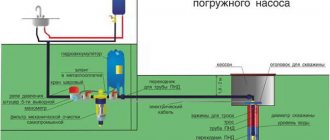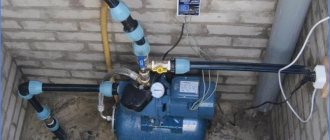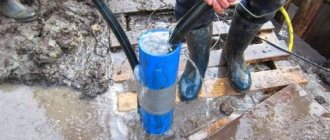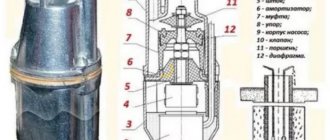The main element of the water supply system is the water supply source. For autonomous systems in private households, dachas or farms, wells or boreholes are used as sources. The principle of water supply is simple: the aquifer fills them with water, which is supplied to users using a pump. When the pump operates for a long time, no matter what its power, it cannot supply more water than the water carrier releases into the pipe.
Any source has a limiting volume of water that it can give to the consumer per unit of time.
Definition
Along with diameter and depth, flow rate is the main parameter of any aquifer well. It determines its productivity - that is, the volume of water in cubic meters that can be obtained over a period of time (minute, hour, day). It is logical that the higher this indicator is, the more benefits it will bring in the end. The choice of pumping equipment depends on this characteristic
Why calculate the flow rate yourself?
- In order to accurately verify the volume that you can receive from an autonomous source in a certain time - for example, necessary for watering, or visiting the bathroom.
- For the correct selection of pumping equipment.
How does the pump's immersion depth affect performance?
Submersible pumps, in accordance with the instructions, must be placed as far as possible from the well filter. At the same time, the normal distance to the static water level should be at least 1 meter.
Attention! The optimal depth of the pump is the point of the most intense water influx.
At the same time, when choosing at what depth to install the pumping station, it should be taken into account that the productivity of the water intake source decreases in proportion to the distance from the bottom. That is, at a depth of 40 meters, where the filter is located in the shaft, the liquid output will be maximum and, according to calculations, will be 3.6 m³/hour.
Whereas at a depth of 28 meters the output will be 1.8 m³/hour, and at a depth equal to the static level the flow rate will be very small. To ensure optimal performance of the domestic water supply, the pump must be located at a depth of 28 to 35 m.
Characteristics used in calculations
To correctly calculate the flow rate, it is necessary to determine the following well characteristics:
- Static level. Determined by the distance from the soil surface to the water table. It is very easy to calculate - just take a long rope, tie a weight to it and lower it into the water intake shaft. When the weight touches the water, mark the desired location on the rope and measure the resulting length.
- The dynamic level is the same distance, but after water is taken. After the pumping equipment is activated, it pumps out a certain volume of water from the well and stops - while a certain water level remains. The distance to it is measured in a manner similar to the previous one.
Dynamic level is a constantly changing value. Depends on the rate of water flow from the source. The ideal option is the equality of the two levels - this means that the pump pumps out at the same speed as a new portion arrives. Accordingly, if the water remains before the pump has time to pump it out, the well’s flow rate will be higher than its productivity, and vice versa.
Measurements must be taken no earlier than one day after the well is fully equipped. This time is enough for the water level in the water intake shaft to stabilize. If measurements are taken earlier, there will be a high probability that they will not correspond to real parameters.
How to calculate well flow using a simplified method
To determine the well flow rate using this method, I use the formula:
D=P:(Hdn-Hst)×Hv
Moreover, the meaning of the symbols corresponds to those previously used.
For example, let's take a specific situation with the following input data:
- the value of the static level Hst is 20m;
- the value of the dynamic level Hdn is 23 m;
- the well depth is 30 m;
- the value of the water column Hb is 10 m;
- pump performance (P) is 1.44 m³/h.
If we substitute the indicated values into the formula, we get:
D=1.44:(23-20)×10=4.8 m³/h
As a result, you can determine with sufficient accuracy the power of the well pump.
There will be no mistake in choosing a well pump if the well flow rate is determined correctly
How to calculate?
To calculate the flow rate, a simple formula is used, which is used by most well owners:
D=V*Hв/(Hdin – Hstat)
Here V is the pump performance (how many cubic meters are pumped out per hour), Hв is the height of the water column (the difference between the depth of the well and the statistical water level), Hdin is a dynamic indicator, Hstat is a statistical indicator.
This method will allow you to find out only the approximate value of the well's flow rate, since there is no direct relationship between the performance of pumping equipment and changes in levels. Simply put, if you take another pump and carry out the same calculations, the result may turn out to be completely different. For more accurate calculations, the Dupuis formula is used.
You can find out the performance of the pump from the technical data sheet, or from the meter of the volume of water consumed.
What to do if the flow rate is insufficient
Over time, the amount of water produced from a well may decrease.
This happens most often for two reasons:
- Silting of the filter and service pipe.
- Reduced pump performance due to a broken or clogged suction filter.
In these cases, you need to decide not how to increase the flow rate of the well, but how to clean it, repair or replace the pump.
The photo shows the process of cleaning the well
If there is not enough water initially, the reasons lie completely different:
- The drillers missed the aquifer. Sometimes the problem is solved by increasing the depth of the well.
- The aquifer does not have sufficient capacity and is simply not capable of producing the required amount of water. In this case, the well can be pumped up.
Rocking is also used to purify water in a well.
with a small debit?
Just pump out all the water from it repeatedly, waiting for maximum filling. If, during the process of rocking, a water pool is formed around the water intake part of the well, it becomes a kind of water reservoir during the period of absence of its extraction, increasing the overall flow rate. But it also happens that neither rocking nor deepening the well solves the problem, and all that remains is to drill a new water intake in another place.
Advice. To prevent this from happening, contact only serious companies with good recommendations for drilling work that can guarantee the fulfillment of your requirements.
Specific value
To accurately determine the flow rate, the above measurements must be carried out at least twice, preferably with different pumps. Of course, in this case one cannot guarantee one hundred percent accuracy, but the result obtained will be more accurate.
After a day, after the previous water intake, when the water column stabilizes and is equal to the calculated static value, pump it out with another pump and measure the dynamic level. Then we substitute the obtained data into the following formula:
Dsp = (V2 – V1)/(H2 – H1)
Here, V2 and V1 are the difference in the performance of the two pumps, and H2 – H1 is the difference between the static and dynamic levels at the first and second intake. Thus, we obtain the specific flow rate of water intake - an indicator by which the real or average flow rate is exceeded as the dynamic level increases.
Real well flow rate
Calculations made using specific flow rate give results close to the real one. However, during calculations, the distance between the wellhead and the beginning of the filtration zone (HF) should be taken into account. Then the real well flow rate (DR) can be calculated using the formula:
DR=DUD×(HF-HST)
For example, let’s assume that the HF value is 28 m. The actual flow rate of the well under this assumption will be:
DR=0.38×(28-20)=3.04 m³/h
As a result of a simplified calculation, we received D = 4.8. However, the actual flow rate turned out to be 37% less than the flow rate calculated by the first method. When choosing a pump for installation in a well, its performance should be 20% less. That is, less than 2.4 m³/h. In other words, less than 58 m³ during the day.
average value
After determining the specific indicator, we reach the finish line and can calculate the average flow rate - the actual value of the well's productivity. It is calculated as follows:
D = (Hph – Hstat)* Dsp
Hf is the level at which the pump filter is located, Hstat is the statistical water level, Dsp is the specific flow rate.
Depending on the obtained value, three types of water wells can be distinguished:
- Low productivity (daily flow rate - no more than 20 m3);
- Medium (from 20 m3);
- High (from 85 m3).
How to calculate using Dupuy's formula?
It is worth noting that it can only be used in pressurized water conditions. There is also one more important condition - the pumping process must be carried out exclusively with one reduction. Dupuy's formula for calculating water reserves looks like this: Q = S / S1 * Q1, where
- Q1 – indicates the quantity after the end of pumping.
- S1 – indicates a specific decrease in the liquid level during water intake.
- S – mirror depth.
How to choose pumping equipment?
Now it remains to determine what pump performance will be most optimal for you. It is not difficult to calculate this parameter - you need to count the number of all water points in the building, and then multiply the resulting number by the volume of water that one point produces per hour.
Don’t bother running for containers - this value is 0.5 m3. As a result, we get the pump performance we need.
It is necessary to carry out such measurements several times a year in order to make sure that water continues to flow into the well in the required quantities. To do this, you only need a measuring cup, a tap and a stopwatch. The time it takes to fill the dishes is measured - if at the next measurement the time matches, then there is nothing to fear, and the source is working at full capacity.
Why is it decreasing?
There are several reasons why the maximum volume level decreases, three common ones are:
- The source has silted up. The main reason for this is that the Abyssinian well, whether on limestone or another type, was drilled by non-professionals. It is important to follow a special technology to eliminate the silting factor.
- The aquifer has exhausted its resources. The reason for this may be that someone drilled a deeper well not far from you. Let’s say yours has a depth of up to 25 meters with a flow rate that is quite enough for a small house. And nearby they built a cottage community, which does not satisfy this volume. They decided to drill deeper. As a result, feeding stopped as the water went deeper. And sometimes the resource of the source is exhausted due to the peculiarities of the geology of your region or severe drought, etc.
- The sand well filter is clogged with clay. This greatly affects the average daily rate that the source will produce.
Reasons for the decline
If, when taking measurements, it turns out that it is taking longer to fill a vessel of the same volume, you should think about it. Most likely, the reason for the decrease in flow rate lies in:
- malfunction of pumping equipment;
- c contamination of the filtration system;
- siltation of the wellbore.
In this case, it is enough to seek help from specialists who will clean the pump filter and, if necessary, replace worn or failed elements.
If these measures do not help, the reason lies in the well itself - or rather, in its improper arrangement, the use of low-quality or unsuitable materials, low-quality filters, etc. In this case, the best solution would be to submit an application to the company that carried out the drilling, or contact another similar organization, since it will not be possible to correct the situation on our own.
Qualified specialists will drain the well for a while, after which they will carry out the necessary diagnostic work and replace faulty elements. These measures are sufficient to correct the vast majority of possible malfunctions in the operation of water-bearing wells.
In addition, the flow rate may decrease due to changes in climate - for example, due to severe drought and lack of precipitation. These changes are temporary and do not have any impact on the well or pumping equipment, so you can only be patient and wait for the weather to change.
Simplified calculation
The flow rate is characterized by the formula. To do this, you need to know and understand how to determine the simplified flow rate of a well. Here you need to find the difference between the dynamic and static water levels and calculate the intensity of the pumping performance of the water column, and then divide the intensity by the calculated difference.
The resulting formula will look like this: the flow rate is equal to the volume of pumped out liquid, divided by the difference between dynamics and statics, and the resulting value is multiplied by the height of the column.
It is best to answer the question of how to calculate the flow rate of a well using a real example:
Let's assume that our source has a depth of 80 m, the static column is 50 m, the pump is capable of pumping out about 3 cubic meters, the dynamic level is 60 m. To calculate the flow rate, we need to divide the pumped volume of liquid (3) by the difference (60 m - 50 m ) and multiply the resulting value by 20. This means that our well will produce about 6 cubic meters per hour.
This is a completely normal value for a family of four. With such a well you can service the bathroom, kitchen, and even place a bathhouse or sauna on your property. Do not forget that the calculations were made taking into account a small error.
Magnification methods
The question most owners ask is how to increase the flow rate of a water well? The answer is simple - practically nothing. A slight change in a positive direction is possible only at the very beginning, when drilling is completed.
By connecting the pump to the well, it is possible to extract a certain amount of foreign inclusions from it, which will increase its overall productivity by 2-3 m3 per hour. However, such measures do not always help.
If the well is used for a long time, no additional reserves for increasing the flow rate will be possible. The only thing that can be done in such a situation is to purchase a hydraulic accumulator of the required volume and connect all or some water points to it. This solution will provide you with the necessary volume of water at relatively low costs.
How to restore flow rate with your own hands?
There are two ways:
- Compression-dispersion. To do this, lower the vibration unit. Under the influence of force waves, all accumulations of dirt or other deposits begin to collapse. This ensures stabilization of the liquid level.
- Chemical reagents. The essence of their action is that they penetrate into cracks, cracks and the like. As a result of these actions, all blockages are destroyed. As a result, the crushed stone or other bottom filter is cleaned. In some cases this helps to raise the average water level.
Important! Before starting work, it is recommended to perform a number of actions aimed at examining the quantity and quality of the aquifer. It is also necessary to determine the depth of the pump and the water surface.
Is recovery possible?
Over time, the wellbore filter can become overgrown with silt particles and become clogged with sand and organic deposits. These natural processes directly affect the reduction in water intake productivity. Restoring debit in this case is possible in two ways:
- Vibration effect. To do this, a special device is used, which is lowered into the water on a cable to the depth of the filter. When it vibrates, accumulations of sand, silt, limestone and other contaminants peel off from the filter.
- Chemical exposure. To do this, the filter is filled with acid, after which all contaminants are dissolved.
In conclusion, it is worth noting once again that carrying out all the above calculations will allow the use of water-bearing equipment efficiently and safely. Accurate calculations will not only provide the required volume of water in free access, but also significantly save on the purchase of related equipment.
Video description
Video about what flow rate is, how to calculate it and which pump to install in the well:
All of the methods discussed above are aimed at restoring the flow rate that has decreased over time, but was initially high. However, there are situations when its value is not enough from the very beginning. In this case, professional specialized companies install a sealed head.
The essence of the technology is that the well channel is filled with water and immediately closed with a sealed cap. This method makes it possible to increase the static-dynamic level, and hence productivity, only by eliminating the influence of atmospheric pressure inside the mine.
